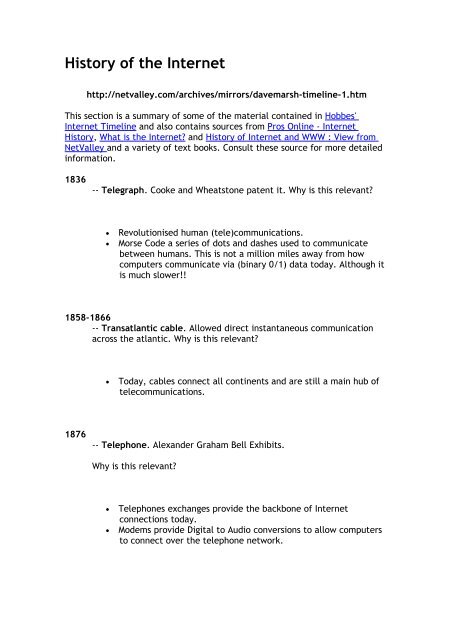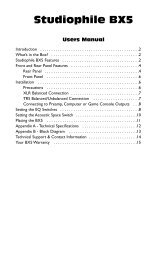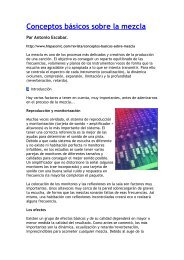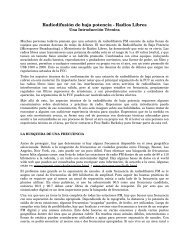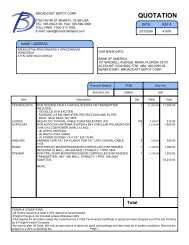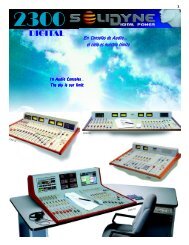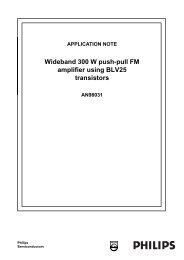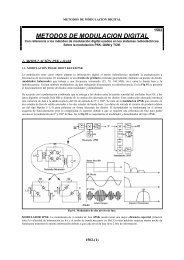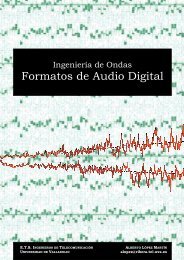History of the Internet
History of the Internet
History of the Internet
You also want an ePaper? Increase the reach of your titles
YUMPU automatically turns print PDFs into web optimized ePapers that Google loves.
• 15 nodes (23 hosts) on ARPANET.• E-mail invented -- a program to send messages across adistributed network. Why is this relevant?oooE-mail is still <strong>the</strong> main way <strong>of</strong> inter-person communicationon <strong>the</strong> <strong>Internet</strong> today.We will study how to use and send E-mail shortly in thiscourse.You will make extensive use <strong>of</strong> E-mail for <strong>the</strong> rest <strong>of</strong> yourlife.1972-- Computers can connect more freely and easily• First public demonstration <strong>of</strong> ARPANET between 40 machines.• <strong>Internet</strong>working Working Group (INWG) created to address needfor establishing agreed upon protocols.Why is this relevant?ooTelnet specificationTelnet is still a relevant means <strong>of</strong> inter-machineconnection today.1973-- Global Networking becomes a reality• First international connections to <strong>the</strong> ARPANET: UniversityCollege <strong>of</strong> London (England) and Royal Radar Establishment(Norway)• E<strong>the</strong>rnet outlined -- this how local networks are basicallyconnected today.• <strong>Internet</strong> ideas started.• Gateway architecture sketched on back <strong>of</strong> envelope in hotellobby in San Francisco. Gateways define how large networks(maybe <strong>of</strong> different architecture) can be connected toge<strong>the</strong>r.• File Transfer protocol specified -- how computers send andreceive data.1974
1983 (Cont)• <strong>Internet</strong> Activities Board (IAB) established, replacing ICCB• Berkeley releases new version <strong>of</strong> UNIX 4.2BSD incorporating TCP/IP.• EARN (European Academic and Research Network) established onsimilar lines to BITNET1984-- Growth <strong>of</strong> <strong>Internet</strong> Continues• Number <strong>of</strong> hosts breaks 1,000.• Domain Name Server (DNS) introduced.o instead <strong>of</strong> 123.456.789.10o it is easier to remember something likewww.myuniversity.mydept.mynetwork.mycountry( e.g. www.cs.cf.ac.uk).• JANET (Joint Academic Network) established in <strong>the</strong> UK• Moderated newsgroups introduced on USENET.1986-- Power <strong>of</strong> <strong>Internet</strong> Realised• 5, 000 Hosts. 241 News groups.• NSFNET created (backbone speed <strong>of</strong> 56 Kbps)• NSF establishes 5 super-computing centers to provide highcomputingpower for all -- This allows an explosion <strong>of</strong>connections, especially from universities.• Network News Transfer Protocol (NNTP) designed to enhanceUsenet news performance over TCP/IP.1987-- Commercialisation <strong>of</strong> <strong>Internet</strong> Born
• Number <strong>of</strong> hosts 28,000.• UUNET is founded with Usenix funds to provide commercial UUCPand Usenet access.1988• NSFNET backbone upgraded to T1 (1.544 Mbps)• <strong>Internet</strong> Relay Chat (IRC) developed1989-- Large growth in <strong>Internet</strong>• Number <strong>of</strong> hosts breaks 100,000• First relays between a commercial electronic mail carrier and<strong>the</strong> <strong>Internet</strong>• <strong>Internet</strong> Engineering Task Force (IETF) and <strong>Internet</strong> ResearchTask Force (IRTF) comes into existence under <strong>the</strong> IAB1990-- Expansion <strong>of</strong> <strong>Internet</strong> continues• 300,000 Hosts. 1,000 News groups• ARPANET ceases to exist• Archie released files can be searched and retrieved (FTP) byname.• The World comes on-line (world.std.com), becoming <strong>the</strong> firstcommercial provider <strong>of</strong> <strong>Internet</strong> dial-up access.1991-- Modernisation Begins• Commercial <strong>Internet</strong> eXchange (CIX) Association, Inc. formedafter NSF lifts restrictions on <strong>the</strong> commercial use <strong>of</strong> <strong>the</strong> Net.• Wide Area Information Servers (WAIS) Why is relevant?
ooooProvides a mechanism for indexing and accessinginformation on <strong>the</strong> <strong>Internet</strong>.Large bodies <strong>of</strong> knowledge available: E-mail messages,text, electronic books, Usenet articles, computer code,image, graphics, sound files, databases etc..These form <strong>the</strong> basis <strong>of</strong> <strong>the</strong> index <strong>of</strong> information we seeon WWW today.Powerful search techniques implemented. Keywordsearch.1991 (cont)-- Friendly User Interface to WWW established• Gopher released by Paul Lindner and Mark P. McCahill from <strong>the</strong> U<strong>of</strong> Minnesota. Why is relevant?oooText based, menu-driven interface to access internetresources.No need to remember or even know complex computercommand. User Friendly Interface (?).Largely superseded by WWW, <strong>the</strong>se days.1991 (cont)-- Most Important development to date• World-Wide Web (WWW) released by CERN; Tim Berners-Leedeveloper. Why is relevant?o Originally developed to provide a distributed hypermediasystem.o Easy access to any form <strong>of</strong> information anywhere in <strong>the</strong>world.o Initially non-graphic (this came later, MOSAIC, 1993).o Revolutionised modern communications and even our, way<strong>of</strong> life (?).• NSFNET backbone upgraded to T3 (44.736 Mbps). NSFNET trafficpasses 1 trillion bytes/month and 10 billion packets/month
• Start <strong>of</strong> JANET IP Service (JIPS) using TCP/IP within <strong>the</strong> UKacademic network.1992-- Multimedia changes <strong>the</strong> face <strong>of</strong> <strong>the</strong> <strong>Internet</strong>• Number <strong>of</strong> hosts breaks 1 Million. News groups 4,000• <strong>Internet</strong> Society (ISOC) is chartered.• First MBONE audio multicast (March) and video multicast(November).• The term "Surfing <strong>the</strong> <strong>Internet</strong>" is coined by Jean Armour Polly.1993-- The WWW Revolution truly begins• Number <strong>of</strong> Hosts 2 Million. 600 WWW sites.• InterNIC created by NSF to provide specific <strong>Internet</strong> serviceso directory and database serviceso registration serviceso information services• Business and Media really take notice <strong>of</strong> <strong>the</strong> <strong>Internet</strong>.• US White House and United Nations (UN) comes on-line.• Mosaic takes <strong>the</strong> <strong>Internet</strong> by storm. Why is this relevant?o User Friendly Graphical Front End to <strong>the</strong> World Wide Web.o Develops into Netscape -- most popular WWW browser todate.o WWW proliferates at a 341,6341994-- Commercialisation begins• Number <strong>of</strong> Hosts 3 Million. 10,000 WWW sites. 10,000 Newsgroups.• ARPANET/<strong>Internet</strong> celebrates 25th anniversary• Local communities begin to be wired up directly to <strong>the</strong> <strong>Internet</strong>(Lexington and Cambridge, Mass., USA)• US Senate and House provide information servers• Shopping malls, banks arrive on <strong>the</strong> <strong>Internet</strong>
o A new way <strong>of</strong> lifeo You can now order pizza from <strong>the</strong> Hut online in <strong>the</strong> US.o First Virtual, <strong>the</strong> first cyberbank, open up for business• NSFNET traffic passes 10 trillion bytes/month• WWW edges out telnet to become 2nd most popular service on<strong>the</strong> Net (behind ftp-data) based on % <strong>of</strong> packets and bytes trafficdistribution on NSFNET• UK's HM Treasury on-line (http://www.hm-treasury.gov.uk/)1995-- Commercialisation continues apace• 6.5 Million Hosts, 100,000 WWW Sites.• NSFNET reverts back to a research network. Main US backbonetraffic now routed through interconnected network providers• WWW surpasses ftp-data in March as <strong>the</strong> service with greatesttraffic on NSFNet based on packet count, and in April based onbyte count• Traditional online dial-up systems (Compuserve, America Online,Prodigy) begin to provide <strong>Internet</strong> access• A number <strong>of</strong> Net related companies go public, with Netscapeleading <strong>the</strong> pack.• Registration <strong>of</strong> domain names is no longer free.• Technologies <strong>of</strong> <strong>the</strong> Year: WWW, Search engines (WAISdevelopment).• New WWW technologies Emerge TechnologiesoooMobile code (JAVA, JAVAscript, ActiveX),Virtual environments (VRML),Collaborative tools (CU-SeeMe)1996-- Micros<strong>of</strong>t enter• 12.8 Million Hosts, 0.5 Million WWW Sites.• <strong>Internet</strong> phones catch <strong>the</strong> attention <strong>of</strong> US telecommunicationcompanies who ask <strong>the</strong> US Congress to ban <strong>the</strong> technology(which has been around for years)• The WWW browser war begins , fought primarily betweenNetscape and Micros<strong>of</strong>t, has rushed in a new age in s<strong>of</strong>twaredevelopment, whereby new releases are made quarterly with


